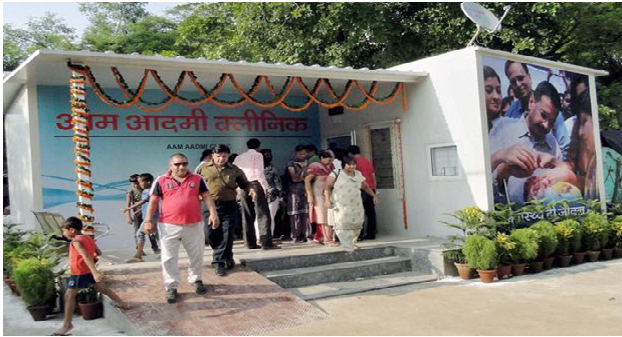In Defence of Public Health And AAP's Mohalla Clinics

PUNE: Odisha TV journalist Ajit Singh has stirred ‘Sensitive India’s’ conscience by the Kodak moment of Dana Manjhi an Orissa tribal carrying the dead body of his wife on his shouldera with 12-year-old sobbing daughter by his side.
“All the money I had was spent on medicines, and the hospital declined to help" said Dana Manjhi. A picture is worth a thousand words. So said a wise man. But in this case, it speaks volumes of our insensitive ruling class and its neglect of the Public Health sector.
The endemic indifference of various governments since independence towards our Public Health sectors is well known. According to sociologist and demographer, Monica Das Gupta of the University of Maryland, the reasons for this neglect are political. Achievements in preventive public health are uneventful and hence electorally less rewarding. No wonder, the expenditure on Public Health has always been equal to, or below one percent of the GDP as against the United Nation’s Millennium development goal of 2.5 % which all nations including India have signed.
During the last two and half decades, the neo-liberal economic policy regime, packaged as the compulsions of Globalization, provided new vigor and vocabulary to the systematic throttling of funding to important social sectors like public health and primary education.
Balancing budgets by cutting social sector expenditure, pricing social goods for full cost recovery, fiscal discipline, became the new buzz words consigning the erstwhile concepts of public welfare and distributive justice to the dustbin.
During the first reform year in 1992-93, the Congress-led UPA Government slashed the health sector expenditure by around 40%. As a result, today, a child born in Nepal or Bangladesh has a better chance at survival than India.
In case of the major human development indicators, we fall behind many least developed countries (LDCs). The sustained and targeted starving of funds has dilapidated the already crumbling public health infrastructure. Whatever little left is being vandalized or traded for personal gains by operating level bureaucracy.
In 2004-05 scholars estimated that the per capita public spending on health was Rs. 242, while private spending was almost four times at Rs. 959. Another study indicates that, only about 20 percent of outpatients and less than 40 percent of in-patients are treated by public facilities. The rest are at the mercy of often unscrupulous and expensive private providers.
The present BJP led Government came to power with among other things, a promise of “health assurance to all Indians and reducing the out-of-pocket spending on health care”. (directly quoted from the BJP election manifesto). However, in the first full year budget, the government slashed expenditure on health sector by 15%, filled only 19 % of specialist vacancies at the rural specialist centers and constructed only half the number of PHCs and CHCs as compared to the previous fiscal year.
Dr. Jayanti Ghosh, Professor of Economics at thJawaharlal Nehru University in New Delhi has the following to say:
“This [cut in health spending] is appalling and unjustifiable since it will be associated with continued stagnation and even deterioration of health indicators in a country where inadequate public health is already a huge problem, and out-of-pocket spending even by the poor is one of the highest in the world, contributing significantly to poverty risks.”
Having committed the nation to the neoliberal policy compact, both Congress and BJP are now orchestrating a grand scale deception on the average Indian. Because "If you invite a bear to dance, it's not you who decides when the dance is over. It's the bear.” So the only way to retain hold over the power is by pulling wool over people's eyes.
The cardinal principle of democracy that; “it requires accountability and consent of the governed, which is only possible if citizens know what is being done in their name”, is long lost. Instead what takes precedence is the nationalistic jingoism of Super Power status and a seat in the UN Security Council.
Seen in this perspective, the visceral disdain of the established political class, cohort of crony capitalists and urban elites towards the Aam Adami Party becomes clear as daylight. AAP is perhaps the only political party which treats itself accountable for its manifesto and puts it into a workable plans. The Delhi government has allocated nearly ten times more budget for public health than what the BJP led government has done at the centre.
AAP’s well designed public health program involves a three tier caregiver system which begins with a modern, adequately staffed and stocked clinical set up, conceived and constructed within reasonable budget. These Mohalla Clinics together with 100 well-located Polyclinics will attend to the most frequent preventive medical needs and thereby decongest the hospitals. Unlike present state government dispensaries, these Mohalla Clinics are an open system capable of using local community resources available on a voluntary basis. This will add an element of extra expertise and sense of dedication in service delivery.
Mohalla Clinic is a project in the making. It may go through iterations and innovations before a viable format is evolved and stabilized. What is heartening is that perhaps for the first time something is being done in right earnest keeping the common man as the focus. The need is to nurture a culture where the welfare of that “last man in the queue” is all that matters for electoral success and not the expenditure at the hustings.
(The writer is a global marketing consultant)



